
New version of the PTRX-7300 has been released ! In this version, output RF connector has been upgraded to the popular threaded SMA connector. After this upgrade, you can connect output of the PTRX-7300 to the SDR directly without the need of any adapter. SMA/SMA coaxial cable assembly is included inside the kit for SDR connection.
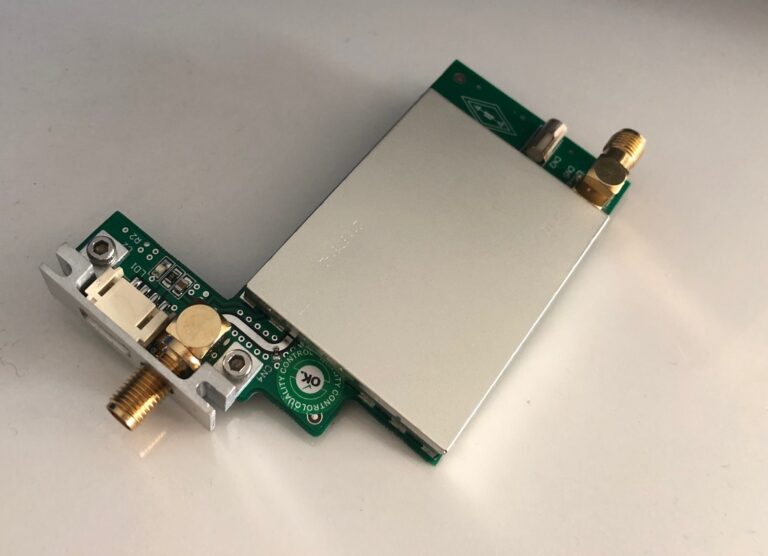
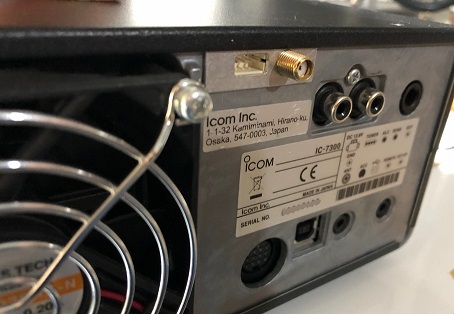

PTRX-7300 PANADAPTER for IC-7300
After carefully inspecting IC-7300’s schematics, pcbs and mechanic, Radio Analog has designed true, innovative panadapter solution for IC-7300 with its professional RF Engineering team. Our unique panadapter solution PTRX-7300 enables you probe internal RF signal of IC-7300 without any degradation on signal quality. With this extention, IC-7300 gains wideband real-time spectrum scope capability. Additionaly, external SDR can function as second independent receiver. Hereafter, you can use your favorite SDR with your IC-7300 by connecting it to standart 50 ohm output connector at the rear panel.
PTRX-7300 is utilizing active high impedance probing technique to sample bidirectional TX/RX signal line. Because circuit is just sniffing (not loading RF signal line), thanks to its high input impedance amplifier, it can not be sensed by the rig and has no adverse effect on normal operation. There is no 3 dB loss as in the case of power splitting approach to sample the signal. Amplifier is designed with state of art components for ultra low distortion and low noise. Active and passive components are from well-known vendors, such as Analog Devices, Texas Instruments, AVX, TE Connectivity, etc. Designed CAD model and manufactured product are shown in Figure 1.
Beside designing high performance amplifer, there is also need for proper connectorized access to RF signal path on IC-7300’s PCB. Fortunately, IC-7300 has a connector on its PCB designated as J1431 where you can sample TX/RX signals. Antenna RX signal reaches this point after passing through input filters and low noise amplifiers. There is also low power TX signal going to Power Amplifier. TX signal level is low enough (<500 mVpeak) to monitor with most SDR hardware.
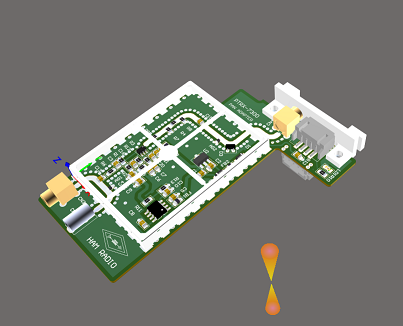
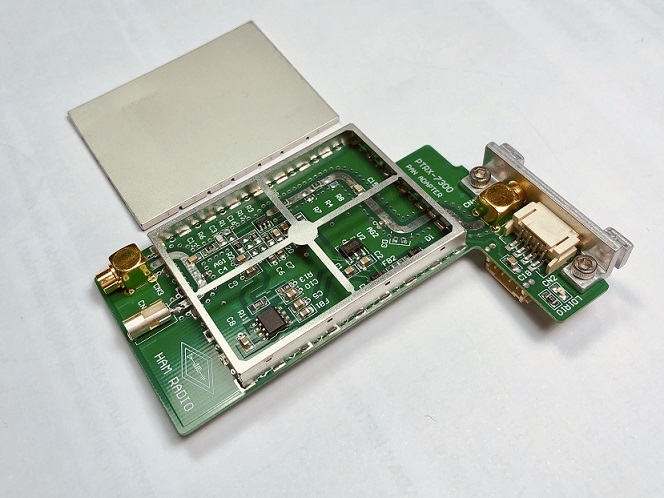
Figure 1: PTRX-7300 CAD Model and Assembled Board
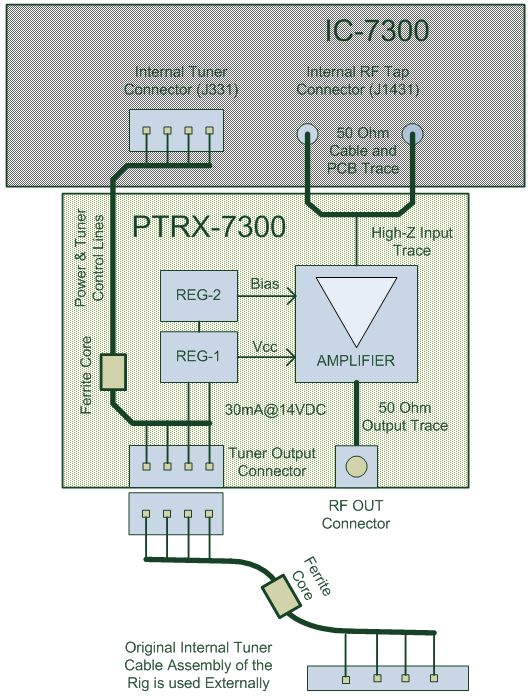
Figure 4: PTRX-7300 Block and Wiring Diagram
PTRX-7300’s schematics, PCB and mechanical model has been specifically designed for IC-7300. Tuner connector opening of the rig on back panel is used as panadapter mounting hole. Bigger size tuner connector has been replaced with a smaller rectangular one, the MCX RF connector which is carrying RF signal also placed beside it. An aluminium fixture is designed and CNC machined to place panadapter to the tuner opening on the back panel of the rig. Figure 2 is showing mounting scheme. Figure 3 is showing back panel RF and Tuner connections of panadapter. Figure 5 is showing previously mentioned tapping point on schematics, layout and wiring diagram of IC-7300 given in service manual.

Figure 2: PTRX-7300 installed in ICOM-7300


Figure 3: Rear View of PTRX-7300 after installation
Amplifier circuit of panadapter also needs a DC power supply to operate. Best way to meet supply requirement is to find a connector carrying DC voltage inside the rig rather than using bulky external power supply. For this purpose we discovered that tuner connector designated as J331 is a good candidate on PA UNIT PCB. This connector is originally passed to back panel of the rig for external tuner connection via a cable assembly. We replaced this cable with a new one and passed tuner connector to the output panel again over panadapter PCB. DC power rails available on tuner connector are used as power supply of the amplifier. Amplifier only draws 30 mA current so doesn’t hurt tuner power rails which is capable of supplying more than one ampere current. Figure 4 is showing block and wiring diagram of panadapter.
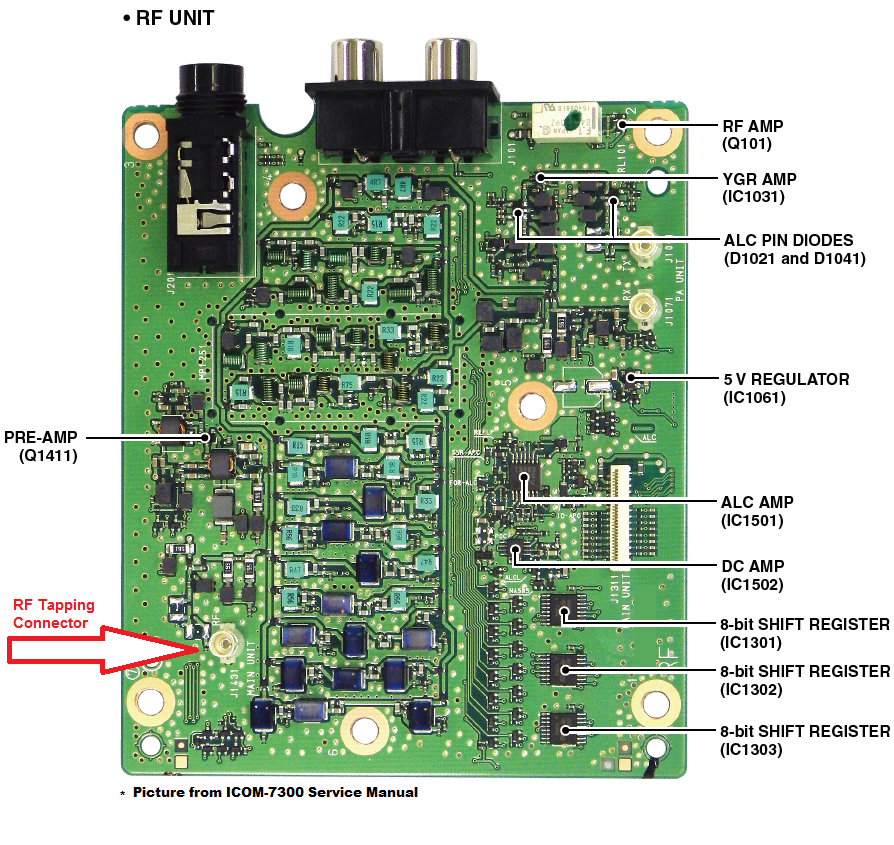
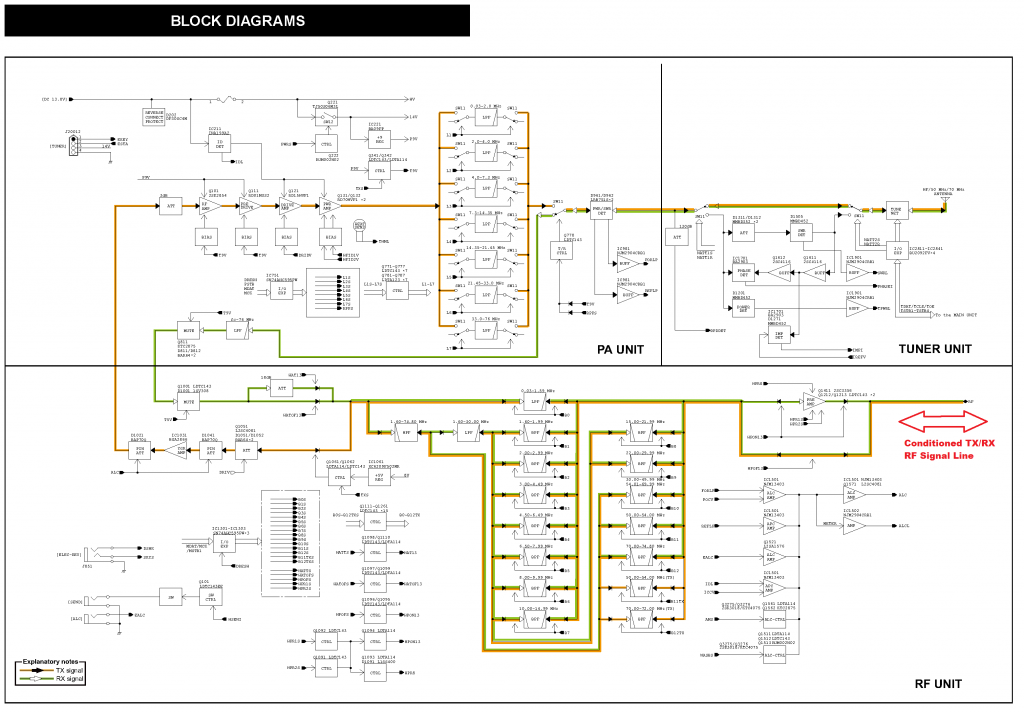
Figure 5: PCB and Schematic pages of IC-7300 showing RF tapping point
COMPARISON TABLE
The table below is showing comparison between PTRX-7300 and typical antenna signal switching/splitting/routing approaches.
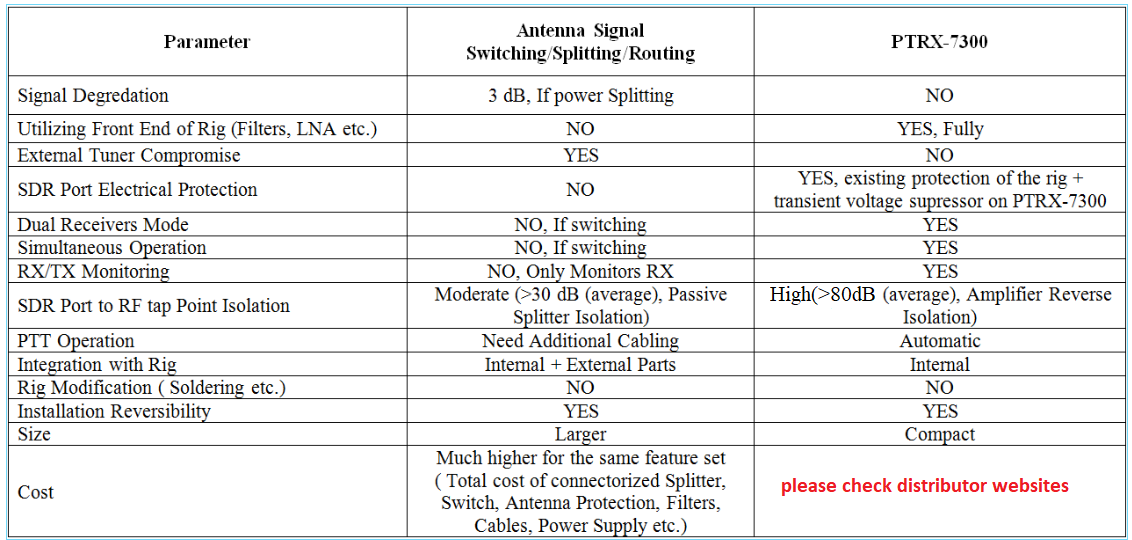
TESTING PTRX-7300
After design and manufacturing period, PTRX-7300 is fistly tested and verified by appliying artificial signals and monitoring output on oscilloscope and spectrum analyzer. Also S-parameter measurements have been conducted in each port. Afterwards PTRX-7300 has been installed and tested in actual working conditions using SDR.
In our RF lab we have professional equipment, such as Spectrum Analyzer, Network Analyzer, Oscilloscopes, Signal Sources and many accessories. We have conducted all tests in house. We will give important test results here.
S-Parameter Measurement
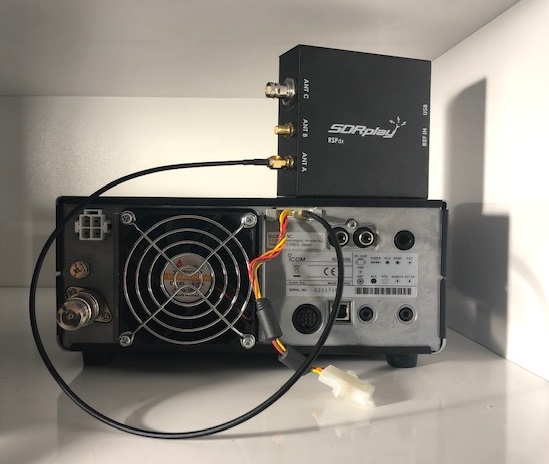
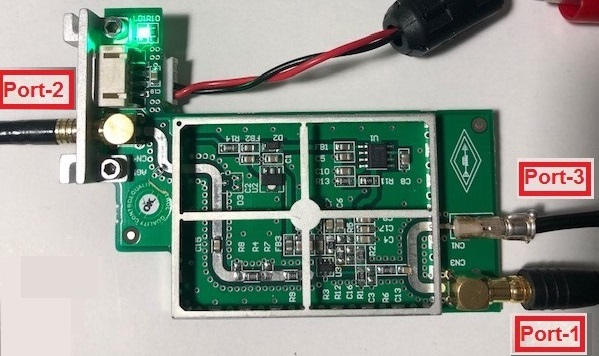
PTRX-7300 is a 3-port device, one output port (SDR port) and two identical input ports. 50 ohm output port, labeled as Port-2 in picture, is connected to network analyzer port-2. Two other ports are labeled as Port-1 and Port-3. These two ports are to be placed in series with RF signal path of IC-7300 and identical, so measuring one port parameter is enough. Network analyzer’s port-1 is connected to Port-1 of PTRX-7300, then full 2-port S-parameter measurement is done. As you can see in graphs below, S11 parameter showing less than -30dB reflection up to 70 MHz which is band edge of the IC-7300. Even, input ports of PTRX-7300 has good matching at 144 MHz, 2 meter amateur band, and beyond. Measurements are conducted between 1MHz-225MHz but for PTRX-7300, checking response up to 70 MHz is enough to evaluate performance.
When we look at S22 parameter which is connected to the PTRX-7300’s Port-2, showing also perfect matching up to 70 MHz and beyond. Reflection is less than -30dB. Other important parameter of a panadapter is transfer function, namely gain from probed RF signal path to the output port. Function of a panadapter is to replicate internal RF signal without disturbing RF signal path, so gain is expected to be around 0 dB and input impedance of the panadapter to be as high as possible compared to 50 Ohm. In figure below, S21 graph showing gain of the PTRX-7300. As you can see it has very flat frequency response up to 70 Mhz and beyond. It is -0.14 dB at 3.2 MHz and -0.22 dB at 70 MHz. This values are not reflecting only PTRX-7300’s insertion loss, but including two 50 cm MCX/SMA RG-174 cables connected to input and output of the PTRX-7300 board to mate network analyzer SMA ports. Total cable loss is about 0.5 dB. If this value is added to S21 parameter, we get insertion gain slightly above 0dB, which proves panadapter is perfectly replicating RF signal of IC-7300.
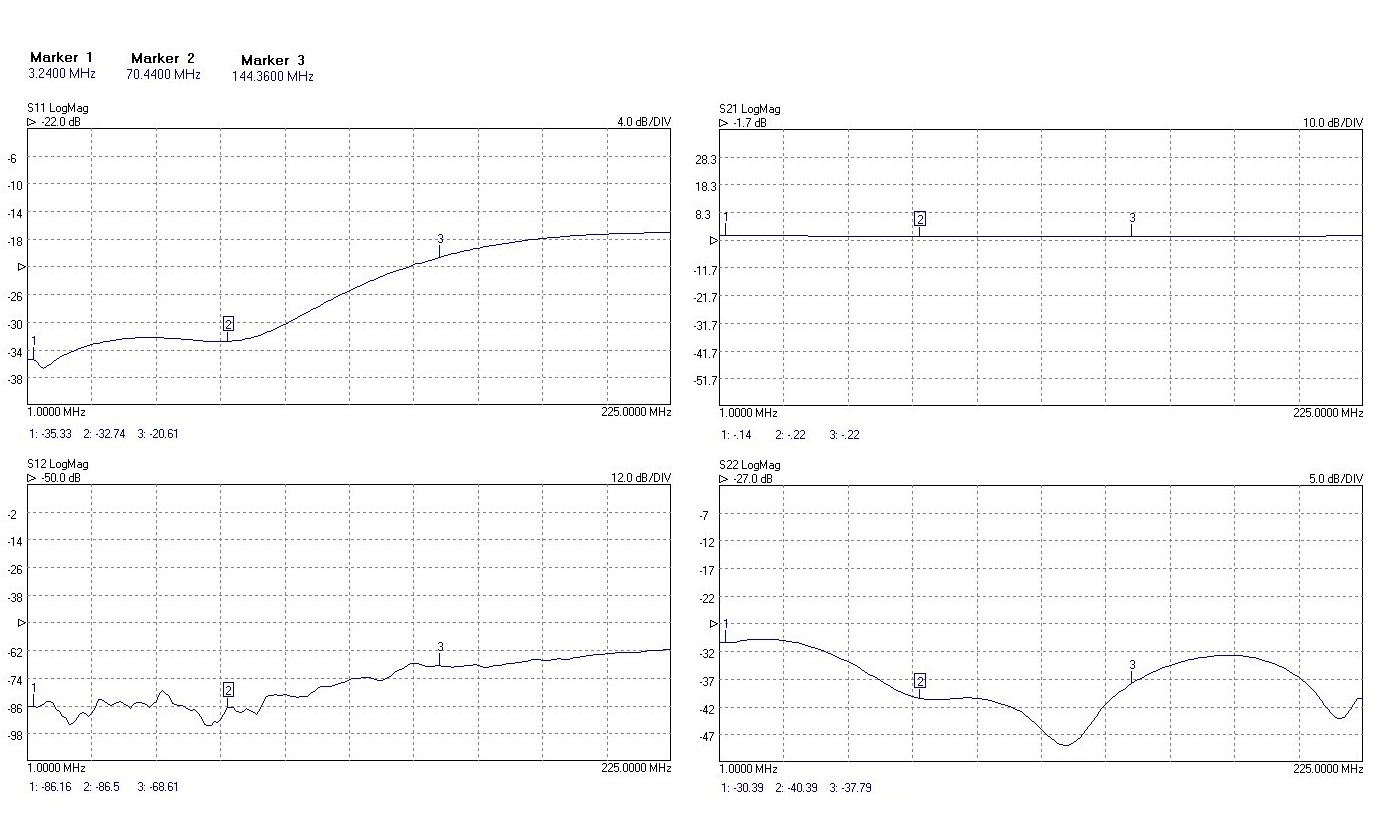
Another important parameter for a panadapter is reverse isolation, which means signal leakage from output port (SDR port) to the input port of the panadapter which is directly connected to signal path of the IC-7300. If there is no proper isolation, SDR’s spurious signals can easily couple to IC-7300 signal path. In S-parameter measurement above, reverse isolation is represented by S12. As you can see, isolation is better than 85 dB up to 70 Mhz, which is very good level. This ensure that even low cost /low perfomance SDR’s high supirous signals hardly to leak RF signal path.
Last parameter should be checked is matching of output (SDR port) of the PTRX-7300. In S-parameter measurement, S22 represents output matching which is better than -30 dB in HF band so that any 50 Ohm SDR can be connected without power loss.
As a result, PTRX-7300 has very good matching at all ports, high reverse islolation, flat frequency response and proper gain which is around 0 dB as expected.
Noise Measurement
While a panapter replicates internal signal, it should not cause any degredation on noise performance. In the noise measurement test, firstly IC-7300 noise level is directly measured with lab grade spectrum analyzer to use as a reference. Then, noise level of the PTRX-7300 is measured under same contidions at the edge of the HF band, 50 MHz. During test, IC-7300 antenna port is terminated with 50 ohm load to avoid any external noise coupling. As you can see from spectrum analyzer screen shots, they are very close to each other. We can conclude that PTRX-7300 noise level is comparable to internal amplifier of the IC-7300.
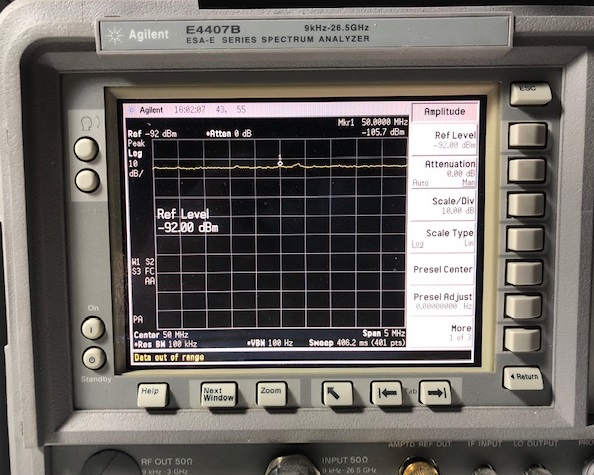
Noise Floor of the IC-7300
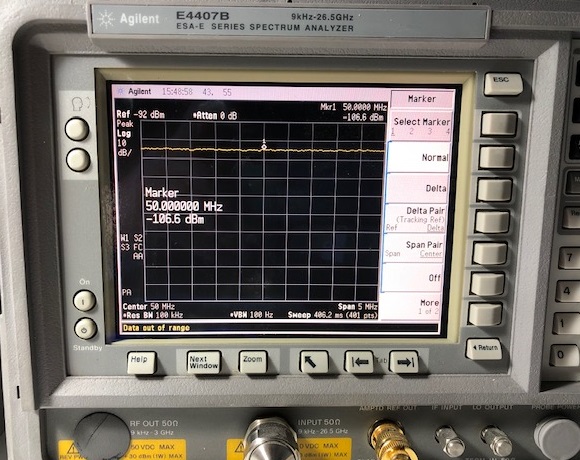
Noise Floor of the PTRX-7300
As you can see in the screenshots above, noise floor of IC-7300 is -105.7 dB while noise floor of PTRX-7300 is -106.6 dBm. PTRX-7300 has slighlty better noise floor than IC-7300. This ensures that IC-7300 and external SDR connected to PTRX-7300’s output port will encounter almost same level of noise so that you can make fair comparison between IC-7300 and your favorite SDR in reception performance.
After giving some fundamental performance metrics of PTRX-7300, we will talk a little bit about fake/copied items on the web that have been showing up recently. Actually, we don’t want to talk about obvious scam/cloning actions on our website but some hams are asking about how to identify original Radio Analog PTRX-7300 and how to buy a legitimate one. Firstly, Radio Analog only sells through reputable distributors (DXengineering, ML&S, WIMO, HRO). Secondly, when you open up shielding box lid, you will see some components are missing in the copied one. In next section, we will give more details about this.
COPYING/CLONING ATTEMPT
After one year later of launching PTRX-7300 and achieving success, a website has appeared trying to promote a copy of our original product PTRX-7300. Well, firstly it is not unexpected as we see many clones in the market but this is way more. Copier has been pretending as if he is promoting the original product with our brand name PTRX-7300 (!) while copied all part numbers (ICs, passive components, connectors, shield box, etc.) as much as possible, removed some components and claimed better performance with irrational technical arguments and graphs. Its PCB layout is primitive as it is obviously designed by a newbie. Besides copying our electronics, mechanic features is also exactly the same as ours, every dimension of our PCB in micron accurracy! Even, the symbols on the PCB such as “OK Quality Label”, Amateur Radio Symbol, etc. are copied entirely. It is obvious that the scammer wants to confuse the marketplace and sell this junk somehow by using illusional marketing tricks. Already some hams are confused about what is happening and have been reaching out to us by asking for truths. We have been sent a clone unit to be reviewed. Hence, for the sake of clarity, we are including some measurements here to show how the specs of the clone are fake, given technical info is fictitious, and how it is attempted to fool the whole world.
Let’s see the noise floor of the clone first before discussing it in details. Under the same conditions, given in the noise measurement section above, we measured what is the noise level of the clone.
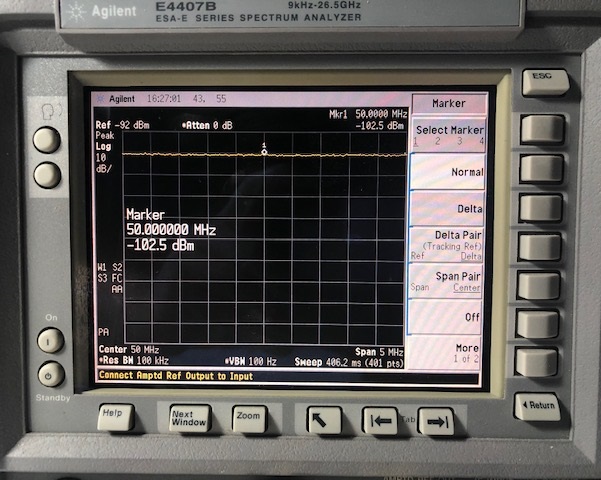
Noise Floor of the Clone

Noise Floor of the Radio Analog PTRX-7300
As it can be seen in screenshots above, the noise floor of the original PTRX-7300 is about 4dB less than the noise floor of the clone ! Obviously, the original product is performing better. Regarding the the noise floor of the IC-7300, as we discussed above, the clone is adding noise to the system and making your SDR reception worse ! As it is seen, the lower noise floor claim for the clone is a lie and the original product performs much better.
There are a lot of wrong technical explanations in clone ads to prove why the clone performs better although it is not. We will discuss only a few of them and be enough to show copier has a lack of basic electrical engineering knowledge. We will give just simple measurements to prove this. Actually, we can write every detail of our design in the technical domain as this is our professional job but we don’t want to train copier here and do a favor.
The first claim is about the removed part of our design which is a voltage regulator LM317. While regulators are designed to stabilize voltage rails, the copier claims this part is adding noise to the circuit. Well, if you have never designed something in RF, you believe that you can use general information from the web in every situation. In RF Engineering, a lack of practical experience always fails.
Let’s see the effect of the LM317 in our design.
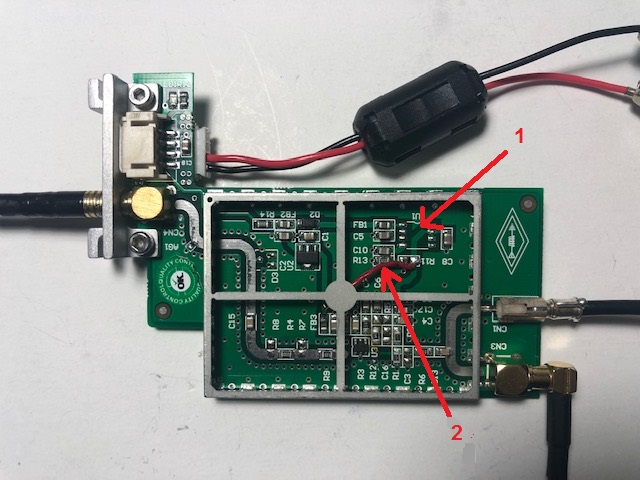
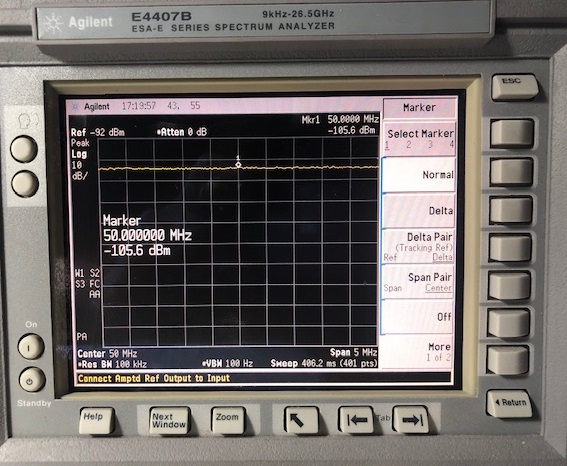
In the picture on the left above, a PTRX-7300 board without LM317 (labeled as 1 in picture) is shown. Requried input bias voltage is suplied via an jumping wire (labeled as 2 in picture) from main regulator. Then noise floor measurement is done under same conditions. On the screenshot of Spectrum Analyzer, its seen that noise floor is about -105.6 dBm which is higher compared to board with LM317 !. This means that LM317 is not adding noise but enhancing or at least not deteriorating noise performance ! Copier claim has failed once again. Actually LM317 is not intended to enhance RF noise floor, it has another function but we will not give detail here and leave as homework to copier. We may talk about it in another episode.
Another unreasonable claim is that series 51 ohm resistor is attenuating input signal. The theory behind attenuation effect of this resistor is very simple but copier is not even aware of this. Because input impedance of the amplifier is very high, 50 ohm resistor has no attenuation effect in practical sense. This resistor is included in most professional amplifiers and theory behind it is totally different. Let’s see its effect through measurements.
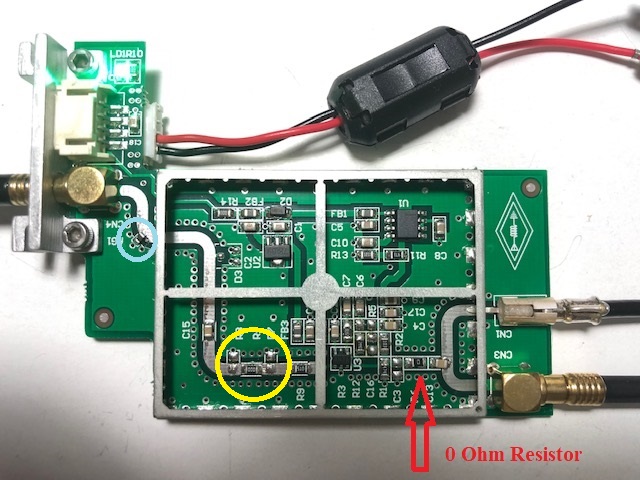
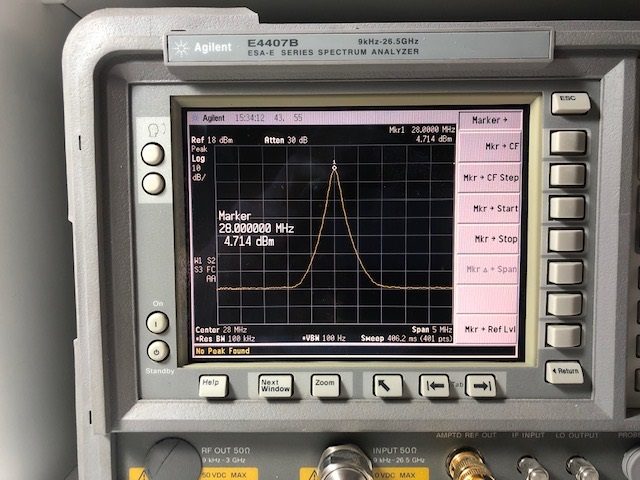
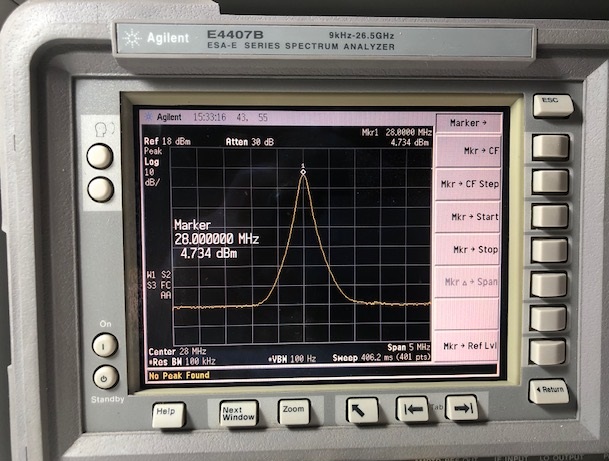
As it seen in the picture on left, 51 Ohm resistor is replaced with 0 Ohm resistor to see its effect. A signal is applied to the input of the PTRX-7300 then output signal is observed with Spectrum Analyzer. Measurement results shown on screenshots above. The difference between two configurations is measured as small as 0.02 dB which is close to measurement uncertanity. Considering net gain of PTRX-7300 is about +0.3 dB, 0.02 dB makes no sense in practice. Increasing gains is very simple with resistor replacement but for a panadapter, gain should be around 0 dB, namely following input signal. Since copier has no practical experience and measurement capability, this resistor effect is considered as an important issue. As we mentioned before, this resistor is included in circuit for different purposes.
Another fictitious claim is that including series zero ohm resistors in circuit deteriorate performance because of its parasitics. This again confirms that copier never used a Network Analyzer and see what is the parasitic effect in practice. Professional radios, such as IC-7300 has not only one zero ohm resistors in signal path but many ! This idiot may claim soon that ICOM has no profficiency in radio design !
The usage of unpopulated footprints in our design enables circuit to be customized by radio amateurs who has hands-on experience. For example circuit part shown in yellow circle above can bu used to add a filter network. You can suppress some part of spectrum to enhance reception of other bands. This may be an unwanted QRM in house disturbing your SDR. Likewise, zero ohm resistors also can be part of this network. Another reason is limiting the bandwidth of the amplifier to avoid noise coupling in a highly noisy environment. As you can see every part, populated or unpopulated included in PCB has a purpose. Likewise, component on output network on PCB (shown in blue circle above) has a purpose. This component couldn’t be identified by copier and replaced with 1 K resistor, but it is not a resistor in original product surely ! Let us leave it as another homework to the copier.
We have already been tired of disclosing absurd, non-technical, and tricky claims so we will mention the rest of them briefly to clarify hams who are asking about. Every part of our product has been tested for quality, such as connectors, PCB, cables, etc. We offer a free replacement in case of any defect and after more than a year, we have had only a few defective boards to be replaced. All customers are happy with our product and classified it as neat and high quality!
Lastly, to be honest copier has added something different which is a fuse ! Because copier is not sure about what he copied, a circuit drawing only 30 mA current is suspected to be a threat for a radio drawing up to 21 Amper current !. The tuner port of the IC-7300 is capable of supplying more than one amper and 30 mA current doesn’t load supply rails. We and hams all over the world have tested our product for more than a year and nobody reported about a failure in the tuner port. IC-7300 already has fuses inside to protect the radio against overloading. Because 30 mA current can not load power rails, it does not effect normal operation. Obviously, the copier has added this component as a marketing trick to fool people pretending as if it is a required feature.
The panadapter concept is well-known in the amateur radio world for many years. There are many panadapter boards on the market for general use as well as for specific radio models. There have been also discussions to design a panadapter for IC-7300, an example is given in the following link: http://vk4zxi.blogspot.
We think it is enough for now to see what has been happening. We may add new technical episodes if there is a demand from the amateur radio world.
Kind Regards, Radio Analog Team